Netgear D6300 User Manual

D6300 WiFi DSL Modem Router
User Manual
November 2013 202-11039-04
350 East Plumeria Drive
San Jose, CA 95134
USA

D6300 WiFi DSL Modem Router
Support
Thank you for selecting NETGEAR products.
After installing your device, locate the serial number on the label of your product and use it to register your product at https://my.netgear.com. You must register your product before you can use NETGEAR telephone support. NETGEAR recommends registering your product through the NETGEAR website. For product updates and web support, visit http://support.netgear.com.
Phone (US & Canada only): 1-888-NETGEAR.
Phone (Other Countries): Check the list of phone numbers at http://support.netgear.com/general/contact/default.aspx.
Trademarks
NETGEAR, the NETGEAR logo, and Connect with Innovation are trademarks and/or registered trademarks of NETGEAR, Inc. and/or its subsidiaries in the United States and/or other countries. Information is subject to change without notice. © NETGEAR, Inc. All rights reserved.
2

Contents
Chapter 1 Hardware Setup
Product Highlights . . . . . . . . . . . . . . . . . . . . . . . . . . . . . . . . . . . . . . . . . . . . 8
Product Specifications . . . . . . . . . . . . . . . . . . . . . . . . . . . . . . . . . . . . . . . . . 9
Unpack Your New Router. . . . . . . . . . . . . . . . . . . . . . . . . . . . . . . . . . . . . . 11
Hardware Features. . . . . . . . . . . . . . . . . . . . . . . . . . . . . . . . . . . . . . . . . . . 12
Label. . . . . . . . . . . . . . . . . . . . . . . . . . . . . . . . . . . . . . . . . . . . . . . . . . . . 12
Back Panel . . . . . . . . . . . . . . . . . . . . . . . . . . . . . . . . . . . . . . . . . . . . . . . 13
Front Panel . . . . . . . . . . . . . . . . . . . . . . . . . . . . . . . . . . . . . . . . . . . . . . . 14
Side Panel . . . . . . . . . . . . . . . . . . . . . . . . . . . . . . . . . . . . . . . . . . . . . . . 17
Position Your Wireless Router . . . . . . . . . . . . . . . . . . . . . . . . . . . . . . . . . . 18
ADSL Microfilters . . . . . . . . . . . . . . . . . . . . . . . . . . . . . . . . . . . . . . . . . . . . 18
One-Line ADSL Microfilter (Not Included) . . . . . . . . . . . . . . . . . . . . . . . 19
Two-Line ADSL Microfilter (Included). . . . . . . . . . . . . . . . . . . . . . . . . . . 19
Summary . . . . . . . . . . . . . . . . . . . . . . . . . . . . . . . . . . . . . . . . . . . . . . . . 20
Cable Your D6300 WiFi DSL Modem Router . . . . . . . . . . . . . . . . . . . . . . . 20
Verify the Cabling . . . . . . . . . . . . . . . . . . . . . . . . . . . . . . . . . . . . . . . . . . . . 21
Chapter 2 Get Started with NETGEAR genie
Prepare to Set Up the WiFi DSL Modem Router . . . . . . . . . . . . . . . . . . . . 23 Use Standard TCP/IP Properties for DHCP . . . . . . . . . . . . . . . . . . . . . . 23 Gather ISP Information. . . . . . . . . . . . . . . . . . . . . . . . . . . . . . . . . . . . . . 23 Wireless Devices and Security Settings . . . . . . . . . . . . . . . . . . . . . . . . . 23 Types of Logins and Access. . . . . . . . . . . . . . . . . . . . . . . . . . . . . . . . . . . . 23 NETGEAR genie Setup . . . . . . . . . . . . . . . . . . . . . . . . . . . . . . . . . . . . . . . 24 Use NETGEAR genie after Installation. . . . . . . . . . . . . . . . . . . . . . . . . . . . 25 Upgrade WiFi DSL Modem Router Firmware. . . . . . . . . . . . . . . . . . . . . . . 25 WiFi DSL Modem Router Dashboard (BASIC Home Screen) . . . . . . . . . .26 Add Wireless Devices or Computers to Your Network . . . . . . . . . . . . . . . .27 Manual Method. . . . . . . . . . . . . . . . . . . . . . . . . . . . . . . . . . . . . . . . . . . . 27 Wi-Fi Protected Setup (WPS) Method . . . . . . . . . . . . . . . . . . . . . . . . . . 27
Chapter 3 NETGEAR genie BASIC Settings
Internet Basic Settings . . . . . . . . . . . . . . . . . . . . . . . . . . . . . . . . . . . . . . . . 30
Internet Basic Settings Screen Fields. . . . . . . . . . . . . . . . . . . . . . . . . . . 30
Attached Devices . . . . . . . . . . . . . . . . . . . . . . . . . . . . . . . . . . . . . . . . . . . . 32
Parental Controls . . . . . . . . . . . . . . . . . . . . . . . . . . . . . . . . . . . . . . . . . . . . 33
ReadySHARE USB Storage and Printer . . . . . . . . . . . . . . . . . . . . . . . . . . 34
USB Storage (Basic Settings) . . . . . . . . . . . . . . . . . . . . . . . . . . . . . . . . 34
ReadySHARE Cloud . . . . . . . . . . . . . . . . . . . . . . . . . . . . . . . . . . . . . . . 35
3

D6300 WiFi DSL Modem Router
ReadySHARE Printer . . . . . . . . . . . . . . . . . . . . . . . . . . . . . . . . . . . . . . . 36 Basic Wireless Settings . . . . . . . . . . . . . . . . . . . . . . . . . . . . . . . . . . . . . . . 37 Wireless Settings Screen Fields. . . . . . . . . . . . . . . . . . . . . . . . . . . . . . . 38 Change WPA Security Option and Passphrase . . . . . . . . . . . . . . . . . . . 39 Guest Networks . . . . . . . . . . . . . . . . . . . . . . . . . . . . . . . . . . . . . . . . . . . . . 40 Guest Network Wireless Security Options . . . . . . . . . . . . . . . . . . . . . . . 41 NETGEAR genie App. . . . . . . . . . . . . . . . . . . . . . . . . . . . . . . . . . . . . . . . . 42 NETGEAR genie Mobile App . . . . . . . . . . . . . . . . . . . . . . . . . . . . . . . . . 43
Chapter 4 NETGEAR genie ADVANCED Home
Setup Wizard . . . . . . . . . . . . . . . . . . . . . . . . . . . . . . . . . . . . . . . . . . . . . . . 45
WPS Wizard . . . . . . . . . . . . . . . . . . . . . . . . . . . . . . . . . . . . . . . . . . . . . . . . 47
Setup Menu . . . . . . . . . . . . . . . . . . . . . . . . . . . . . . . . . . . . . . . . . . . . . . . . 48
ADSL Setup . . . . . . . . . . . . . . . . . . . . . . . . . . . . . . . . . . . . . . . . . . . . . . . . 49
WAN Setup. . . . . . . . . . . . . . . . . . . . . . . . . . . . . . . . . . . . . . . . . . . . . . . . . 50
Default DMZ Server . . . . . . . . . . . . . . . . . . . . . . . . . . . . . . . . . . . . . . . . 51
Change the MTU Size . . . . . . . . . . . . . . . . . . . . . . . . . . . . . . . . . . . . . . 51
LAN Setup . . . . . . . . . . . . . . . . . . . . . . . . . . . . . . . . . . . . . . . . . . . . . . . . . 53
LAN Setup Screen Settings . . . . . . . . . . . . . . . . . . . . . . . . . . . . . . . . . . 54
Use the WiFi DSL Modem Router as a DHCP Server . . . . . . . . . . . . . . 55
Address Reservation . . . . . . . . . . . . . . . . . . . . . . . . . . . . . . . . . . . . . . . 56
Quality of Service Setup. . . . . . . . . . . . . . . . . . . . . . . . . . . . . . . . . . . . . . . 56
Chapter 5 USB Storage
USB Drive Requirements . . . . . . . . . . . . . . . . . . . . . . . . . . . . . . . . . . . . . . 62 ReadySHARE Access . . . . . . . . . . . . . . . . . . . . . . . . . . . . . . . . . . . . . . . . 62 File-Sharing Scenarios . . . . . . . . . . . . . . . . . . . . . . . . . . . . . . . . . . . . . . . . 63 USB Storage Basic Settings. . . . . . . . . . . . . . . . . . . . . . . . . . . . . . . . . . . . 64 Add or Edit a Network Folder . . . . . . . . . . . . . . . . . . . . . . . . . . . . . . . . . 66 USB Storage Advanced Settings . . . . . . . . . . . . . . . . . . . . . . . . . . . . . . . . 67 Safely Remove a USB Drive . . . . . . . . . . . . . . . . . . . . . . . . . . . . . . . . . . . 68 Media Server Settings . . . . . . . . . . . . . . . . . . . . . . . . . . . . . . . . . . . . . . . . 69 Specify Approved USB Devices . . . . . . . . . . . . . . . . . . . . . . . . . . . . . . . . . 70 Connect to the USB Drive from a Remote Computer. . . . . . . . . . . . . . . . . 71 Access the WiFi DSL Modem Router’s USB Drive Remotely Using FTP71
Chapter 6 USB Printer Control
Control Center Configuration . . . . . . . . . . . . . . . . . . . . . . . . . . . . . . . . . . . 74 USB Printer . . . . . . . . . . . . . . . . . . . . . . . . . . . . . . . . . . . . . . . . . . . . . . . . 74 Scan with a Multifunction Printer . . . . . . . . . . . . . . . . . . . . . . . . . . . . . . . . 75
Chapter 7 Security
Keyword Blocking of HTTP Traffic . . . . . . . . . . . . . . . . . . . . . . . . . . . . . . . 77 Firewall Rules. . . . . . . . . . . . . . . . . . . . . . . . . . . . . . . . . . . . . . . . . . . . . . . 78 Add Custom Services to Allow or Block . . . . . . . . . . . . . . . . . . . . . . . . . . . 80
4

D6300 WiFi DSL Modem Router
Schedule for Firewall Rules . . . . . . . . . . . . . . . . . . . . . . . . . . . . . . . . . . . .82 Security Event Email Notifications . . . . . . . . . . . . . . . . . . . . . . . . . . . . . . .83
Chapter 8 Administration
Upgrade the WiFi DSL Modem Router Firmware. . . . . . . . . . . . . . . . . . . .85 View WiFi DSL Modem Router Status . . . . . . . . . . . . . . . . . . . . . . . . . . . .86 Router Information . . . . . . . . . . . . . . . . . . . . . . . . . . . . . . . . . . . . . . . . .86 Internet Port . . . . . . . . . . . . . . . . . . . . . . . . . . . . . . . . . . . . . . . . . . . . . .86 Wireless Settings (2.4 GHz and 5 GHz) . . . . . . . . . . . . . . . . . . . . . . . . .88 Guest Network (2.4 GHz and 5 GHz) . . . . . . . . . . . . . . . . . . . . . . . . . . .89 View Logs of Web Access or Attempted Web Access . . . . . . . . . . . . . . . .89 Attached Devices . . . . . . . . . . . . . . . . . . . . . . . . . . . . . . . . . . . . . . . . . . . .90 Manage the Configuration File . . . . . . . . . . . . . . . . . . . . . . . . . . . . . . . . . .90 Back Up Settings . . . . . . . . . . . . . . . . . . . . . . . . . . . . . . . . . . . . . . . . . .91 Restore Configuration Settings. . . . . . . . . . . . . . . . . . . . . . . . . . . . . . . .91 Erase . . . . . . . . . . . . . . . . . . . . . . . . . . . . . . . . . . . . . . . . . . . . . . . . . . .91 Set Password . . . . . . . . . . . . . . . . . . . . . . . . . . . . . . . . . . . . . . . . . . . . . . .92 Password Recovery . . . . . . . . . . . . . . . . . . . . . . . . . . . . . . . . . . . . . . . .92 Diagnostics . . . . . . . . . . . . . . . . . . . . . . . . . . . . . . . . . . . . . . . . . . . . . . . . .93
Chapter 9 Advanced Settings
Advanced Wireless Settings. . . . . . . . . . . . . . . . . . . . . . . . . . . . . . . . . . . .96 Wireless Repeating Function (WDS) . . . . . . . . . . . . . . . . . . . . . . . . . . . . .99 Wireless Repeating Function . . . . . . . . . . . . . . . . . . . . . . . . . . . . . . . .100 Set Up the Base Station . . . . . . . . . . . . . . . . . . . . . . . . . . . . . . . . . . . .101 Set Up a Repeater Unit. . . . . . . . . . . . . . . . . . . . . . . . . . . . . . . . . . . . .101 Port Forwarding and Triggering . . . . . . . . . . . . . . . . . . . . . . . . . . . . . . . .102 Remote Computer Access Basics . . . . . . . . . . . . . . . . . . . . . . . . . . . .102 Port Triggering to Open Incoming Ports . . . . . . . . . . . . . . . . . . . . . . . .104 Port Forwarding to Permit External Host Communications . . . . . . . . .105 How Port Forwarding Differs from Port Triggering . . . . . . . . . . . . . . . .106 Set Up Port Forwarding to Local Servers . . . . . . . . . . . . . . . . . . . . . . . . .106 Add a Custom Service . . . . . . . . . . . . . . . . . . . . . . . . . . . . . . . . . . . . .108 Edit or Delete a Port Forwarding Entry . . . . . . . . . . . . . . . . . . . . . . . . .108 Set Up Port Triggering . . . . . . . . . . . . . . . . . . . . . . . . . . . . . . . . . . . . . . .109 Dynamic DNS . . . . . . . . . . . . . . . . . . . . . . . . . . . . . . . . . . . . . . . . . . . . . .111 Static Routes . . . . . . . . . . . . . . . . . . . . . . . . . . . . . . . . . . . . . . . . . . . . . .112 Remote Management . . . . . . . . . . . . . . . . . . . . . . . . . . . . . . . . . . . . . . . .115 Universal Plug and Play . . . . . . . . . . . . . . . . . . . . . . . . . . . . . . . . . . . . . .116 IPv6 . . . . . . . . . . . . . . . . . . . . . . . . . . . . . . . . . . . . . . . . . . . . . . . . . . . . .118 Traffic Meter . . . . . . . . . . . . . . . . . . . . . . . . . . . . . . . . . . . . . . . . . . . . . . .118 USB Settings . . . . . . . . . . . . . . . . . . . . . . . . . . . . . . . . . . . . . . . . . . . . . .119
Chapter 10 Troubleshooting
Quick Tips. . . . . . . . . . . . . . . . . . . . . . . . . . . . . . . . . . . . . . . . . . . . . . . . .121
Sequence to Restart Your Network . . . . . . . . . . . . . . . . . . . . . . . . . . .121
5

D6300 WiFi DSL Modem Router
Check Ethernet Cable Connections . . . . . . . . . . . . . . . . . . . . . . . . . . . 121 Wireless Settings . . . . . . . . . . . . . . . . . . . . . . . . . . . . . . . . . . . . . . . . . 121 Network Settings . . . . . . . . . . . . . . . . . . . . . . . . . . . . . . . . . . . . . . . . . 121 Troubleshoot with the LEDs . . . . . . . . . . . . . . . . . . . . . . . . . . . . . . . . . . . 122 Power LED Is Off or Blinking . . . . . . . . . . . . . . . . . . . . . . . . . . . . . . . . 122 Power LED Stays Red . . . . . . . . . . . . . . . . . . . . . . . . . . . . . . . . . . . . . 122 LEDs Never Turn Off . . . . . . . . . . . . . . . . . . . . . . . . . . . . . . . . . . . . . . 123 Internet or Ethernet Port LEDs Are Off. . . . . . . . . . . . . . . . . . . . . . . . . 123 Wireless LEDs Are Off . . . . . . . . . . . . . . . . . . . . . . . . . . . . . . . . . . . . . 123 The Push 'N' Connect (WPS) Button Blinks Green . . . . . . . . . . . . . . . 123 Cannot Log In to the Router . . . . . . . . . . . . . . . . . . . . . . . . . . . . . . . . . . . 124 Cannot Access the Internet . . . . . . . . . . . . . . . . . . . . . . . . . . . . . . . . . . . 125 Troubleshoot PPPoE . . . . . . . . . . . . . . . . . . . . . . . . . . . . . . . . . . . . . . 126 Troubleshoot Internet Browsing . . . . . . . . . . . . . . . . . . . . . . . . . . . . . . 126 Changes Not Saved . . . . . . . . . . . . . . . . . . . . . . . . . . . . . . . . . . . . . . . . . 127 Incorrect Date or Time . . . . . . . . . . . . . . . . . . . . . . . . . . . . . . . . . . . . . . . 127 Wireless Connectivity . . . . . . . . . . . . . . . . . . . . . . . . . . . . . . . . . . . . . . . . 128 Wireless Signal Strength . . . . . . . . . . . . . . . . . . . . . . . . . . . . . . . . . . . 128 Restore the Factory Settings and Password . . . . . . . . . . . . . . . . . . . . . . 128 Troubleshoot Your Network Using the Ping Utility . . . . . . . . . . . . . . . . . . 129 Test the LAN Path to Your Router . . . . . . . . . . . . . . . . . . . . . . . . . . . . 129 Test the Path from Your Computer to a Remote Device . . . . . . . . . . . 130
Appendix A Supplemental Information
Factory Settings . . . . . . . . . . . . . . . . . . . . . . . . . . . . . . . . . . . . . . . . . . . . 131
Technical Specifications. . . . . . . . . . . . . . . . . . . . . . . . . . . . . . . . . . . . . . 133
Appendix B Notification of Compliance
Index
6

1. Hardware Setup |
1 |
Get to know your wireless router |
The NETGEAR D6300 WiFi DSL Modem Router offers maximum-performance wireless speeds of up to 300+13001 Mbps2 needed for demanding applications, such as large file transfers, streaming HD video, and multiplayer gaming. Complete with a built-in DSL modem, it is compatible with all major DSL Internet service providers. Simultaneous dual-band technology runs both 2.4 and 5 GHz bands at the same time, ensuring top speeds and the greatest range, while Gigabit offers ultrafast wired connections. The unit supports a wide range of premium features and applications such as ReadySHARE®Cloud, ReadySHARE® Printer, and NETGEAR genie®.
The WiFi DSL modem router automatically uses NETGEAR Beamforming+ technology to enhance WiFi performance. Because it’s automatic, you don’t have to turn on Beamforming+ or configure it. When you connect to the WiFi network, Beamforming+ focuses on your location for even better WiFi performance and speed. Beamforming+ locks onto your laptop, tablet, or smartphone, and follows as you move from place to place, so you keep your optimal WiFi connection.
This chapter contains the following sections:
•Product Highlights
•Product Specifications
•Unpack Your New Router
•Hardware Features
•Position Your Wireless Router
•ADSL Microfilters
•Cable Your D6300 WiFi DSL Modem Router
•Verify the Cabling
For more information about the topics covered in this manual, visit the support website at http://support.netgear.com.
1.Up to 1300 Mbps wireless speeds achieved when connecting to other 802.11ac 1300 Mbps devices.
2.Maximum wireless signal rate derived from IEEE standard 802.11 specifications. Actual data throughput and wireless coverage will vary. Network conditions and environmental factors, including volume of network traffic, building materials and construction, and network overhead, lower actual data throughput rate and wireless coverage. NETGEAR makes no express or implied representations or warranties about this product’s compatibility with any future standards. 802.11ac 1300 Mbps is approximately 3x faster than 802.11n 450 Mbps.
7

D6300 WiFi DSL Modem Router
Product Highlights
The modem router has the following capabilities:
•All-in-one. Built-in ADSL2+ modem and WAN Gigabit Ethernet port for cable or fiber combined with a wireless router create an integrated home gateway.
•ReadySHARE Cloud. Access and share files on an attached USB hard drive anywhere you have an Internet connection.
•ReadySHARE Printer. Wirelessly print from your Mac or PC to a connected USB printer.
•ReadySHARE USB. Wirelessly share a USB hard drive with Macs and PCs.
•Faster multimedia streaming. Provides up to 450 Mbps wireless speed for streaming HD videos, simultaneous downloads, and online gaming in addition to basic Internet applications.
•Simultaneous dual band. Runs both 2.4 and 5 GHz bands concurrently, ensuring top speeds and the greatest range while minimizing interference.
•NETGEAR genie. Easy setup and dashboard control to manage, monitor, and repair home networks.
•Ultrafast wired. Four Gigabit Ethernet ports deliver ultrafast wired connections for gaming and video.
•Live Parental Controls. Keeps your Internet experience safe using flexible and customizable filter settings.
•Guest network access. Provides separate security and access restrictions for guests using the network.
•Broadband usage meter. Monitors Internet traffic and sends customized reports to help keep costs under control.
•Secured connection. Push 'N' Connect ensures a quick and secure network connection.
•NETGEAR green features. Use Power and WiFi On/Off buttons, and schedule WiFi to turn on and off to save energy when not in use.
•Compatibility. Compatible with all major ADSL Internet service providers (ISPs).
Hardware Setup
8

D6300 WiFi DSL Modem Router
Product Specifications
Package Contents
•D6300 WiFi DSL Modem Router
•Ethernet cable
•Phone cable and filter
•Power adapter, localized to country of sale
Warranty
•Localized to country of sale System Requirements
•Broadband Internet service
-ADSL broadband Internet service
-Cable or fiber. Connects to cable modem or fiber termination node through the Gigabit Ethernet WAN port
•802.11-a/b/g/n 2.4-GHz or 5.0-GHz specification wireless adapter or an Ethernet adapter and cable for each computer
•Microsoft Windows 7, Vista, XP, 2000, Me, Mac OS, UNIX, or Linux
•Microsoft Internet Explorer 5.0, Firefox 2.0, Safari 1.4, or later
•Use with an N600 Wireless Dual Band USB Adapter (WNDA3100 for maximum performance)
Standards
•IEEE 802.11-b/g/n 2.4 GHz
•IEEE 802.11-a/n 5.0 GHz
•Five (5) 10/100/1000 (1 WAN and 4 LAN) Gigabit Ethernet ports
•Two (2) USB 2.0 ports
•One (1) ADSL2+ port Performance
•All-in-one. High-speed ADSL2+ modem (built-in) and WAN Gigabit Ethernet port for cable or fiber
•Powerful dual-core (400 MHz each) processor
•High-speed access to external USB storage using two USB 2.0 ports
•Memory. 128 MB flash and 128 MB RAM
•Five (5) (1 WAN, 4 LAN) Gigabit-Ethernet ports
•Advanced Quality of Service (QoS)
Security
•Wi-Fi Protected Access® (WPA/WPA2-PSK) and WEP
Hardware Setup
9

D6300 WiFi DSL Modem Router
•Double firewall protection (SPI and NAT firewall)
•Denial of service (DoS) attack prevention Ease of Use
•Easy installation. Connect to computer and open your browser to install
•Push 'N' Connect using Wi-Fi Protected Setup® (WPS)
Physical Specifications
• Dimensions: 205 x 255 x 77 mm (8.07 x 10.04 x 3.03 inches)
•Weight: 654g (1.44 lb) Premium Features:
•ReadySHARE CLOUD. Access and share a USB hard drive remotely.
•ReadySHARE PRINTER. Wirelessly access and share a USB printer.
Advanced Features
•Live Parental Controls with flexible and customizable filter settings.
•Simultaneous dual band. 2.4 GHz and 5 GHz operation.
•Two (2) ports for ReadySHARE® USB storage access. Supports FAT16/32, NTFS Read/Write.
•DLNA®. Stream media to DLNA media players.
•Multiple SSID guest networks (separate security and access restrictions).
•Broadband usage meter measures Internet usage.
•Power and Wi-Fi On/Off buttons.
NETGEAR Green Features
Power On/Off button
80% recycled packaging
CEC (California Efficiency)
RoHS
WEEE
If you have not already set up your new router using the installation guide that comes in the box, this chapter walks you through the hardware setup. Chapter 3, NETGEAR genie BASIC Settings, explains how to set up your Internet connection.
For more information about the topics covered in this manual, visit the support website at http://support.netgear.com/general/contact/default.aspx.
Hardware Setup
10
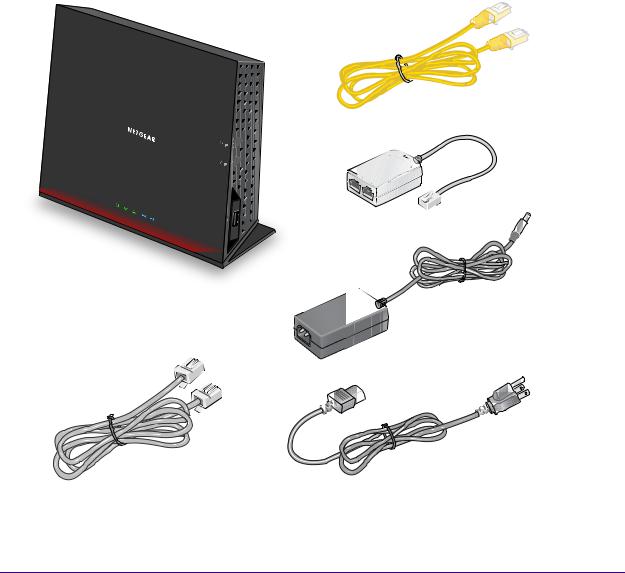
D6300 WiFi DSL Modem Router
Unpack Your New Router
Your box should contain the following items:
•D6300 WiFi DSL Modem Router
•AC power adapter (plug varies by region)
•Category 5 (Cat 5) Ethernet cable
•Telephone cable with RJ-11 connector
•Microfilters and splitters (quantity and type vary by region)
•Installation guide with cabling and router setup instructions
If any of the parts are incorrect, missing, or damaged, contact your NETGEAR dealer. Keep the carton, including the original packing materials, in case you need to return the product for repair. See Position Your Wireless Router on page 18 for information about where to place and how to position your router.
Ethernet cable
Filter splitter
D6300
Modem Router
Power adapter (2 parts)
Telephone cable
Figure 1. Box contents
Hardware Setup
11
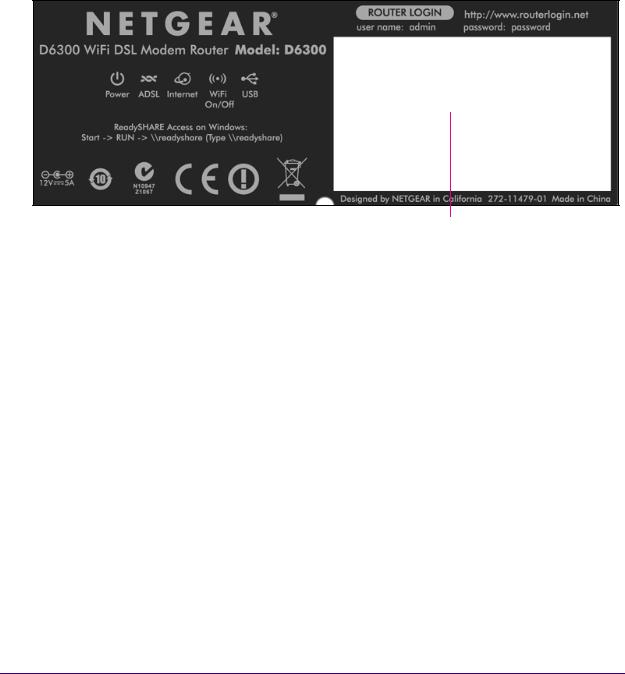
D6300 WiFi DSL Modem Router
Hardware Features
Before you cable your router, take a moment to become familiar with the label and the front and back panels. Pay particular attention to the LEDs on the front panel.
Label
The label on the bottom of the WiFi DSL modem router shows the router’s WiFi network name (SSID) and network key (password).
WiFi network name (SSID) and Network key (password)
Figure 2. Label on router bottom
Hardware Setup
12
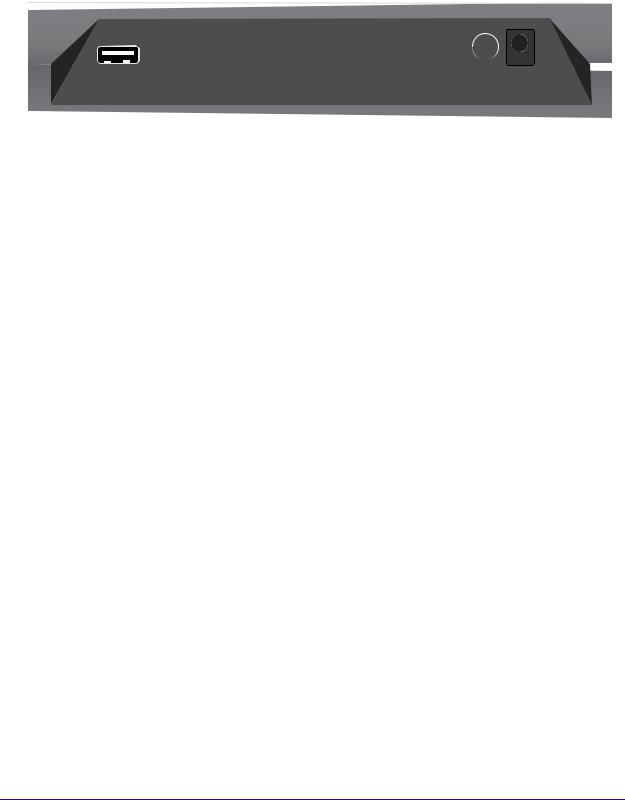
D6300 WiFi DSL Modem Router
Back Panel
The back panel has the Power On/Off button and port connections shown in the figure:
|
|
|
|
|
|
|
|
|
|
|
|
|
|
|
|
|
|
|
|
|
|
|
|
|
|
|
|
|
|
|
|
|
|
|
|
|
|
|
|
|
|
|
|
|
|
|
|
|
|
|
|
|
|
|
|
|
|
|
|
|
|
|
|
|
|
|
|
|
|
|
|
|
|
|
|
|
|
|
|
|
|
|
|
|
|
|
|
|
|
|
|
|
|
|
|
|
|
|
|
|
|
|
|
|
|
|
|
|
|
|
|
|
|
|
|
|
|
|
|
|
|
|
|
|
|
|
|
|
|
|
|
|
|
|
|
|
|
|
|
|
|
|
|
|
|
|
|
|
|
|
|
|
|
|
|
|
|
|
|
|
|
|
|
|
|
|
|
|
|
|
|
|
|
|
|
|
|
|
|
|
|
|
|
|
|
|
|
|
|
|
|
|
|
|
|
|
|
|
|
|
|
|
|
|
|
|
|
|
|
|
|
|
|
|
|
|
|
|
|
|
|
|
|
|
|
|
|
|
|
|
|
|
|
|
|
|
|
|
|
|
|
|
|
|
|
|
|
|
|
|
|
|
|
|
|
|
|
|
|
|
|
|
|
|
|
|
|
|
|
|
|
|
|
|
|
|
|
|
|
|
|
|
|
|
|
|
|
|
|
|
|
|
|
|
|
|
|
|
|
|
|
|
|
|
|
|
|
|
|
|
|
|
|
|
|
|
|
|
|
|
|
|
|
|
|
|
|
|
|
|
|
|
|
|
|
|
|
|
|
|
|
|
|
|
|
|
|
|
|
|
|
|
|
|
|
|
|
|
|
|
|
|
|
|
|
|
|
|
|
|
|
|
|
|
|
|
|
|
|
|
|
|
|
|
|
|
|
|
|
|
|
|
|
|
|
|
|
|
|
|
|
|
|
|
|
|
|
|
|
|
|
|
|
|
|
|
|
|
|
|
|
|
|
|
|
|
|
|
|
|
|
|
|
|
|
|
|
|
|
|
|
|
|
|
|
|
|
|
|
|
|
|
|
|
|
|
|
|
|
|
|
|
|
|
|
|
|
1. USB port |
|
|
|
3. Gigabit Ethernet |
|
|
|
7. Power |
|||||||||||||||||||||||||||||||||||||||||||
|
2. ADSL line |
|
LAN ports |
|
|
|
On/Off button |
||||||||||||||||||||||||||||||||||||||||||||
|
|
|
|
|
|
|
|
|
|
|
|
|
|
|
|
|
|
|
|
|
|
|
|
|
|
|
|
|
|
|
|
|
|
|
|
|
|
|
6. AC power |
||||||||||||
|
|
|
|
|
|
|
|
|
|
|
|
|
|
|
|
|
|
|
|
|
|
|
|
|
|
|
|
|
|
|
|
|
|
|
|
|
|
|
|
|
|
|
|
|
|
|
|
|
|||
|
|
|
|
|
|
|
|
|
|
|
|
|
|
|
|
|
|
|
|
|
|
|
|
4. Gigabit Ethernet |
|||||||||||||||||||||||||||
|
|
|
|
|
|
|
|
|
|
|
|
|
|
|
|
|
|
|
|
|
|
|
|
|
|
adapter input |
|||||||||||||||||||||||||
|
|
|
|
|
|
|
|
|
|
|
|
|
|
|
|
|
|
|
|
|
|
|
|
WAN port |
5. Reset button |
||||||||||||||||||||||||||
|
|
|
|
|
|
|
|
|
|
|
|
|
|
|
|
|
|
|
|
|
|
|
|
|
|
|
|
|
|
|
|
|
|
|
|
|
|
|
|
|
|
|
|
|
|
|
|||||
Figure 3. Back panel port connections
Viewed from left to right, the back panel contains the following elements:
1.USB port for connecting USB storage devices like flash drives, hard drives, or USB printers.
2.RJ-11 asynchronous DSL (ADSL) port for connecting the WiFi DSL modem router to an ADSL line
Note: An ADSL port can send data over an ADSL line at one speed and receive it at another speed.
3.Four Gigabit Ethernet RJ-45 LAN ports for cabling the WiFi DSL modem router to the local computers
4.One Gigabit Ethernet WAN port for connecting the WiFi DSL modem router to a fiber or cable modem
Note: You can use either the ADSL or Gigabit Ethernet port for WAN connectivity.
5.Reset button
See Factory Settings on page 131 for information about the Restore Factory Settings button and the factory setting values.
Hardware Setup
13
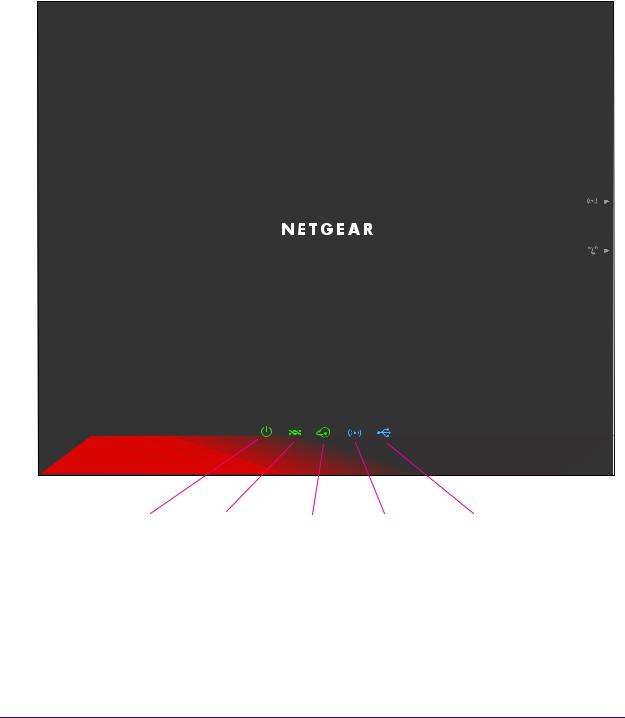
D6300 WiFi DSL Modem Router
6.Power On/Off button
7.AC power adapter input
Front Panel
The WiFi DSL modem router front panel has the 5 status LEDs, icons, and ports shown in the figure.
Power |
DSL |
Internet |
Wireless |
USB |
Figure 4. Front panel LEDs
The following tables describe the LEDs and icons on the front panel from left to right.
Hardware Setup
14
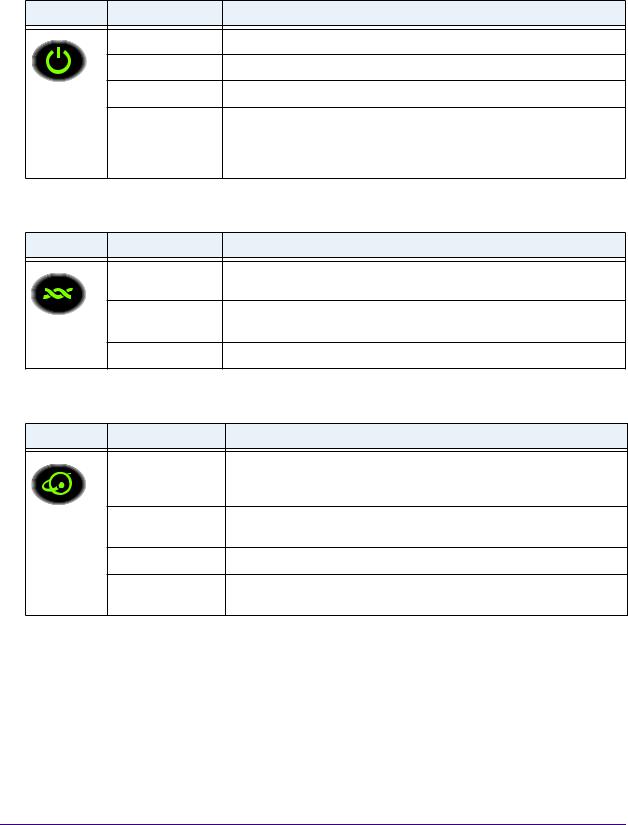
D6300 WiFi DSL Modem Router
Table 1. Power On/Off LED
Icon |
LED Activity |
Description |
|
Solid green |
Power is supplied to the router. |
|
Solid red |
POST (power-on self-test) failure or a device malfunction has occurred. |
|
Off |
Power is not supplied to the router. |
|
Restore Factory |
LED blinks momentarily when the Restore Factory Settings button on the |
|
Settings |
bottom of the unit is pressed for 6 seconds. The Power LED then blinks red |
|
|
three times when the Restore Factory Settings button is released and then |
|
|
turns green as the gateway resets to the factory defaults. |
Table 2. DSL LED
Icon |
LED Activity |
Description |
|
Solid green |
You have an ADSL connection. In technical terms, the ADSL port is |
|
|
synchronized with an ISP’s network-access device. |
|
Blinking green |
Indicates that the WiFi DSL modem router is negotiating the best possible |
|
|
speed on the ADSL line. |
|
Off |
The unit is off or there is no ADSL connection. |
Table 3. |
Internet LED |
|
Icon |
LED Activity |
Description |
|
Solid green |
You have an Internet connection. If this connection is dropped due to an |
|
|
idle time-out but the connection is still present, the LED stays green. If the |
|
|
Internet connection is dropped for any other reason, the LED turns off. |
|
Solid red |
The Internet (IP) connection failed. See Cannot Access the Internet on |
|
|
page 125 for troubleshooting information. |
|
Blinking green |
Data is being transmitted over the Internet connection. |
|
Off |
No Internet connection is detected or the device is in bridge mode (an |
|
|
external device handles the ISP connection). |
Hardware Setup
15
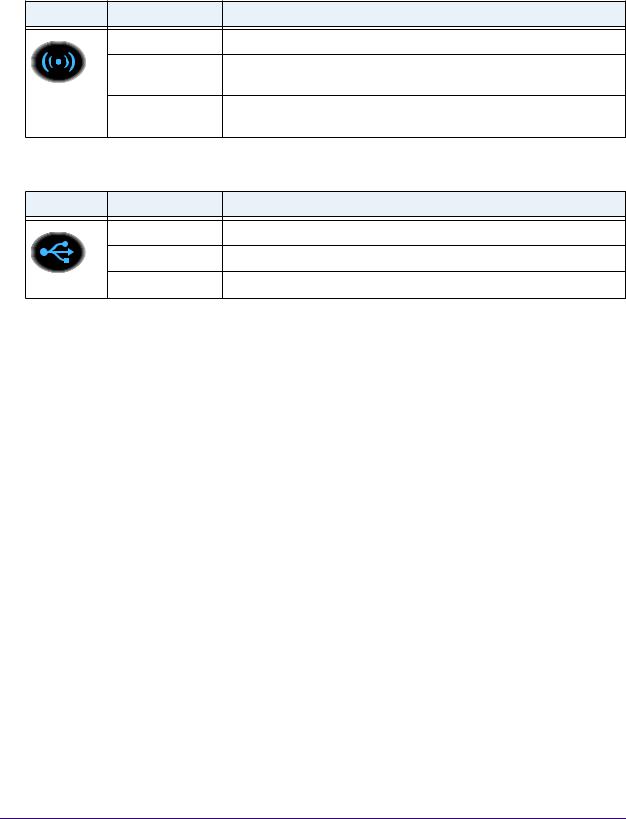
D6300 WiFi DSL Modem Router
Table 4. Wireless LED
Icon |
LED Activity |
Description |
|
Solid blue |
There is wireless connectivity. |
|
Blinking blue |
Data is being transmitted or received over a wireless link or a |
|
|
WPS-capable device is connecting to the device. |
|
Off |
There is no wireless connectivity. You can still plug an Ethernet cable into |
|
|
one of the LAN ports to get wired connectivity. |
Table 5. USB LED
Icon |
LED Activity |
Description |
|
Solid green |
A USB port has detected a USB device. |
|
Blinking green |
Data is being transmitted or received. |
|
Off |
No link is detected on these ports. |
Hardware Setup
16
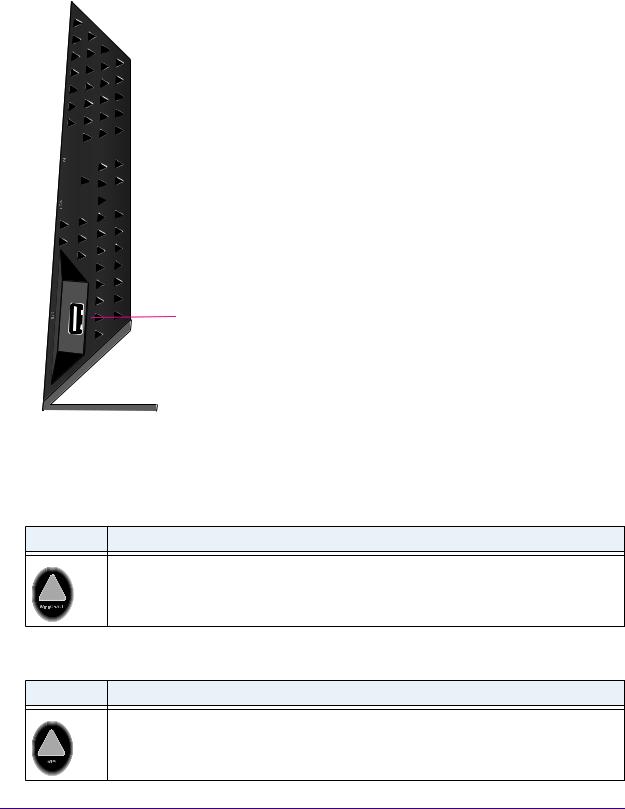
D6300 WiFi DSL Modem Router
Side Panel
The WiFi DSL modem router side panel has the port and buttons shown in the figure.

 Wireless On/Off button
Wireless On/Off button

 WPS On/Off button
WPS On/Off button
USB port
Figure 5. Side panel buttons and port
The following tables describe the buttons and port on the side panel from top to bottom.
Table 6. Wireless button
Icon Description
For information about the use of this button, see Wireless Connectivity on page 128.
Table 7. WPS button
Icon Description
For information about the use of this button, see Wi-Fi Protected Setup (WPS) Method on page 27.
Hardware Setup
17
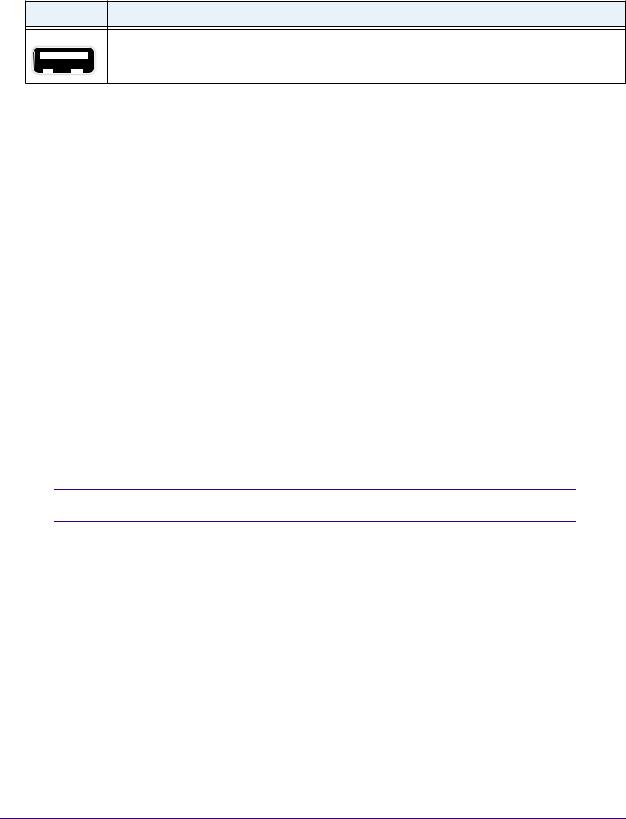
D6300 WiFi DSL Modem Router
Table 8. USB port
Icon Description
USB port for connecting USB storage devices like flash drives or hard drives.
Position Your Wireless Router
The WiFi DSL modem router lets you access your network from anywhere within the operating range of your wireless network. However, the operating distance or range of your wireless connection can vary significantly depending on the physical placement of your router. For example, the thickness and number of walls the wireless signal passes through can limit the range. For best results, place your router:
•Near the center of the area where your computers and other devices operate, and preferably within line of sight to your wireless devices.
•So it is accessible to an AC power outlet and near Ethernet cables for wired computers.
•In an elevated location such as a high shelf, keeping the number of walls and ceilings between the WiFi DSL modem router and your other devices to a minimum.
•Away from electrical devices that are potential sources of interference, such as ceiling fans, home security systems, microwaves, computers, or the base of a cordless phone or 2.4-GHz cordless phone.
•Away from any large metal surfaces, such as a solid metal door or aluminum studs. Large expanses of other materials such as glass, insulated walls, fish tanks, mirrors, brick, and concrete can also affect your wireless signal.
Note: The D6300 should be put in a vertical position only.
Also be aware that when you use multiple access points, it is better if adjacent access points use different radio frequency channels to reduce interference. The recommended channel spacing between adjacent access points is five channels (for example, use Channels 1 and 6, or 6 and 11).
ADSL Microfilters
If this is the first time you have cabled a wireless router between an ADSL phone line and your computer or laptop, you might not be familiar with ADSL microfilters. If you are, you can skip this section and proceed to Cable Your D6300 WiFi DSL Modem Router on page 20.
An ADSL microfilter is a small inline device that filters ADSL interference out of standard phone equipment that shares line with your ADSL service. Every telephone device that
Hardware Setup
18
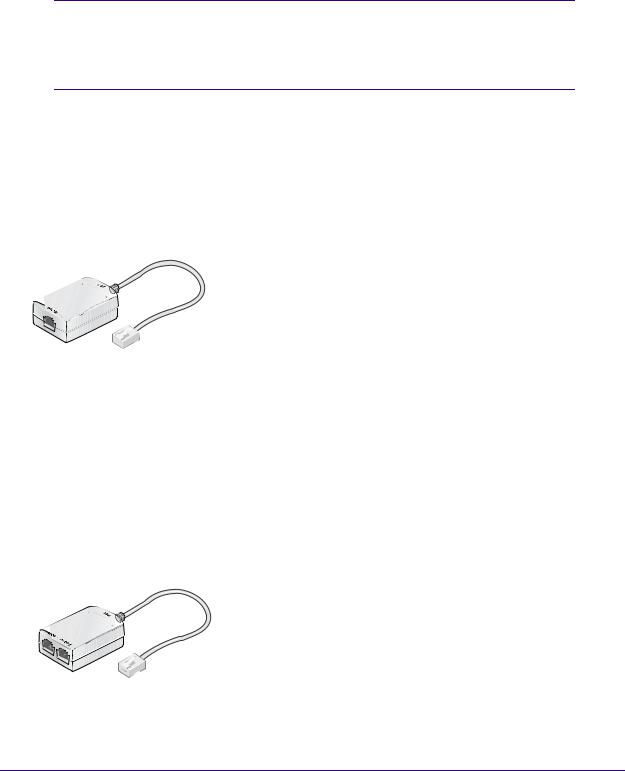
D6300 WiFi DSL Modem Router
connects to a telephone line that provides ADSL service needs an ADSL microfilter to filter out the ADSL interference. Example devices are telephones, fax machines, answering machines, and caller ID displays. Not every phone line in your home necessarily carries ADSL service. That depends on the ADSL service setup in your home.
Note: Often the ADSL microfilter is included in the box with the wireless modem router. If you purchased the WiFi DSL modem router in a country where a microfilter is not included, you have to acquire the ADSL microfilter separately.
One-Line ADSL Microfilter (Not Included)
Plug the ADSL microfilter into the wall outlet and plug your phone equipment into the jack labeled Phone. The wireless modem router plugs directly into a separate ADSL line. Plugging the wireless modem router into the phone jack blocks the Internet connection. If you do not have a separate ADSL line for the router, the best thing to do is to use an ADSL microfilter with a built-in splitter.
Plugs into ADSL line
Figure 6. One-line ADSL microfilter
Second best when you do not have a separate ADSL line for the router is to get a separate splitter. To use a one-line filter with a separate splitter, insert the splitter into the phone outlet, connect the one-line filter to the splitter, and connect the phone to the filter.
Two-Line ADSL Microfilter (Included)
Use an ADSL microfilter with a built-in splitter when there is a single wall outlet that provides connectivity for both the WiFi DSL modem router and your telephone equipment. Plug the ADSL microfilter into the wall outlet, plug your phone equipment into the jack labeled Phone, and plug the wireless modem router into the jack labeled ADSL.
Plugs into the ADSL line
Figure 7. Two-line ADSL microfilter with built-in splitter
Hardware Setup
19
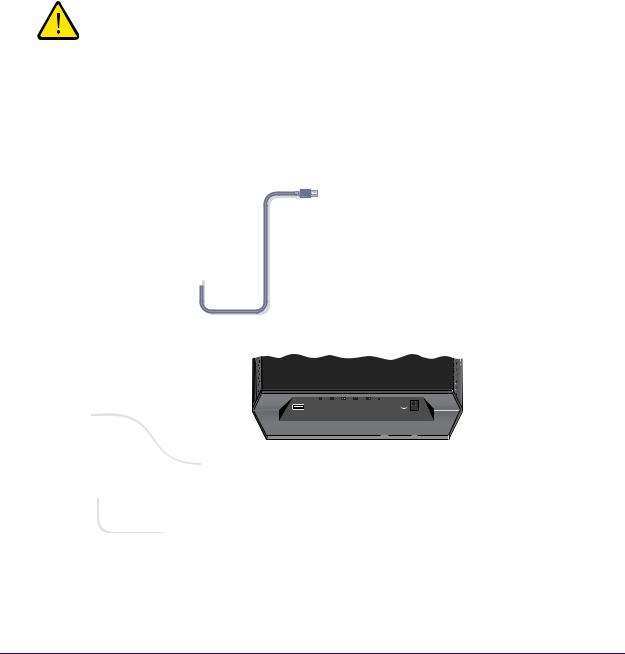
D6300 WiFi DSL Modem Router
Summary
•One-line ADSL microfilter (not included). Use with a phone or fax machine.
•Splitter (not included). Use with a one-line ADSL microfilter to share an outlet with a phone and the WiFi DSL modem router.
•Two-line ADSL microfilter with built-in splitter (included). Use to share an outlet with a phone and the WiFi DSL modem router.
Cable Your D6300 WiFi DSL Modem Router
WARNING:
DO not stack equipment, or place equipment in tight spaces, or in drawers. Be sure that your equipment is surrounded by at least 2 inches of air space. The unit should not be wall mounted.
The installation guide that came in the box has a cabling diagram on the second page.
4 Browser
3 Computer
1 ADSL or Cable Fiber Modem
2 Power
Figure 8. Cabling diagram
Hardware Setup
20

D6300 WiFi DSL Modem Router
CAUTION:
Incorrectly connecting a filter to your WiFi DSL modem router blocks your ADSL connection.
Verify the Cabling
Verify that your router is cabled correctly by checking the WiFi DSL modem router LEDs. Turn on the wireless router by pressing the Power On/Off button on the back.
• The Power LED is green when the modem router is turned on.
The Power LED is green when the modem router is turned on.
• The Wireless LED is lit when the modem router is turned on.
The Wireless LED is lit when the modem router is turned on.
• The DSL LED is green when you have an ADSL connection.
The DSL LED is green when you have an ADSL connection.
• The Internet LED is green when there is an Internet connection.
The Internet LED is green when there is an Internet connection.
Turn on your computer. If software usually logs you in to your Internet connection, do not run that software. Cancel it if it starts automatically.
Hardware Setup
21

2. Get Started with NETGEAR genie |
2 |
Connect to the WiFi DSL modem router |
This chapter explains how to use NETGEAR genie to set up your WiFi DSL modem router after you complete cabling as described in the installation guide and in the previous chapter in this book.
This chapter contains the following sections:
•Prepare to Set Up the WiFi DSL Modem Router
•Types of Logins and Access
•NETGEAR genie Setup
•Use NETGEAR genie after Installation
•Upgrade WiFi DSL Modem Router Firmware
•WiFi DSL Modem Router Dashboard (BASIC Home Screen)
•Add Wireless Devices or Computers to Your Network
22

D6300 WiFi DSL Modem Router
Prepare to Set Up the WiFi DSL Modem Router
You can set up your WiFi DSL modem router with the NETGEAR genie automatically, or you can use the genie menus and screens to set up your WiFi DSL modem router manually. However, before you start the setup process, you need to have your ISP information on hand and make sure the laptops, computers, and other devices in the network have the settings described here.
Use Standard TCP/IP Properties for DHCP
If you set up your computer to use a static IP address, you need to change the settings so that it uses Dynamic Host Configuration Protocol (DHCP).
Gather ISP Information
If you have DSL broadband service, you might need the following information to set up your WiFi DSL modem router and to check that your Internet configuration is correct. Your Internet service provider (ISP) should have provided you with all of the information needed to connect to the Internet. If you cannot locate this information, ask your ISP to provide it. When your Internet connection is working, you no longer need to launch the ISP’s login program on your computer to access the Internet. When you start an Internet application, your WiFi DSL modem router automatically logs you in.
•The ISP configuration information for your DSL account
•ISP login name and password
•Fixed or static IP address settings (special deployment by ISP; this situation is rare)
Wireless Devices and Security Settings
Make sure that the wireless device or computer that you are using supports WPA or WPA2 wireless security, which is the wireless security supported by the WiFi DSL modem router. See Basic Wireless Settings on page 37 for information about the WiFi DSL modem router’s preconfigured security settings.
Types of Logins and Access
There are two separate types of logins that have different purposes. It is important that you understand the difference so that you know which login to use when.
•Wireless modem router login logs you in to the WiFi DSL modem router interface from NETGEAR genie. See Use NETGEAR genie after Installation on page 25 for details about this login.
Get Started with NETGEAR genie
23

D6300 WiFi DSL Modem Router
Wireless network key or password. Your WiFi DSL modem router is preset with a unique wireless network name (SSID) and password for wireless access. This information is on the label located on the bottom of your WiFi DSL modem router.
•ISP login logs you in to your Internet service. Your service provider has provided you with this login information in a letter or some other way. If you cannot find this login information, contact your service provider.
NETGEAR genie Setup
NETGEAR genie runs on any device with a web browser. It is the easiest way to set up the WiFi DSL modem router because it automates many of the steps and verifies that those steps have been successfully completed. It takes about 15 minutes to complete.
To use NETGEAR genie to set up your WiFi DSL modem router:
1.Turn the WiFi DSL modem router on by pressing the On/Off button, if not done yet.
2.Make sure that your device is connected with an Ethernet cable to your WiFi DSL modem router.
3.Launch your Internet browser.
•If this is the first time you are setting up the Internet connection for your WiFi DSL modem router, the browser automatically goes to http://www.routerlogin.net, and the NETGEAR genie screen displays.
•If you already used the NETGEAR genie, type http://www.routerlogin.net in the address field for your browser to display the NETGEAR genie screen. See Use NETGEAR genie after Installation on page 25.
4.Follow the onscreen instructions to complete NETGEAR genie setup. NETGEAR genie guides you through connecting the WiFi DSL modem router to the Internet.
If the browser cannot display the web page:
• Make sure that the computer is connected to one of the four Gigabit Ethernet LAN ports, or wirelessly to the WiFi DSL modem router.
• Make sure that the WiFi DSL modem router is ready. Its Wireless LEDs should light.
• Close and reopen the browser to make sure the browser does not cache the previous page.
• Browse to http://routerlogin.net.
• If your computer is set to a static or fixed IP address (this is uncommon), change the setting to obtain an IP address automatically from the WiFi DSL modem router.
If the WiFi DSL modem router does not connect to the Internet:
1.Review your settings to be sure that you have selected the correct options and typed everything correctly.
2.Contact your ISP to verify that you have the correct configuration information.
3.Read Chapter 10, Troubleshooting. If problems persist, register your NETGEAR product and contact NETGEAR technical support.
Get Started with NETGEAR genie
24
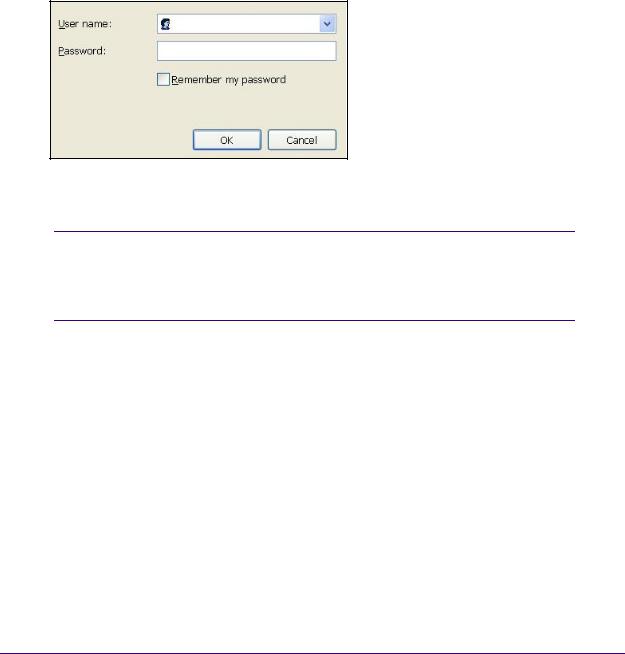
D6300 WiFi DSL Modem Router
Use NETGEAR genie after Installation
When you first set up your WiFi DSL modem router, NETGEAR genie automatically starts when you launch an Internet browser on a computer that is connected to the WiFi DSL modem router. You can use NETGEAR genie again if you want to view or change settings for the WiFi DSL modem router.
1.Launch your browser from a computer or wireless device that is connected to the WiFi DSL modem router.
2.Type http://www.routerlogin.net or http://www.routerlogin.com. The login window displays:
admin
********
3.Enter admin for the WiFi DSL modem router user name and password for the WiFi DSL modem router password, both in lowercase letters.
Note: The WiFi DSL modem router user name and password are different from the user name and password for logging in to your Internet connection. See Types of Logins and Access on page 23 for more information.
Upgrade WiFi DSL Modem Router Firmware
When you set up your WiFi DSL modem router and are connected to the Internet, the WiFi DSL modem router automatically checks for you to see if newer firmware is available. If it is, a message is displayed on the top of the screen. See Upgrade the WiFi DSL Modem Router Firmware on page 85 for more information about upgrading firmware.
Click the message when it shows up, and click Yes to upgrade the WiFi DSL modem router with the latest firmware. After the upgrade, the WiFi DSL modem router restarts.
Get Started with NETGEAR genie
25
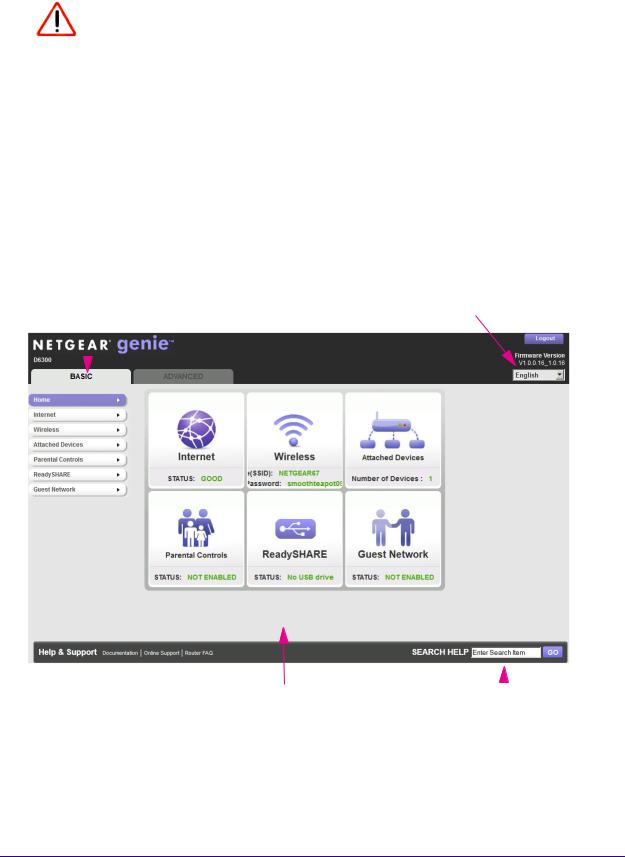
D6300 WiFi DSL Modem Router
CAUTION:
Do not try to go online, turn off the WiFi DSL modem router, shut down the computer, or do anything else to the WiFi DSL modem router until the WiFi DSL modem router finishes restarting and the Power LED has stopped blinking for several seconds.
WiFi DSL Modem Router Dashboard (BASIC Home
Screen)
The WiFi DSL modem router BASIC Home screen has a dashboard that lets you see the status of your Internet connection and network at a glance. You can click any of the six sections of the dashboard to view more detailed information. The left column has the menus, and at the top there is an ADVANCED tab that is used to access additional menus and screens.
Menus (Click the Advanced tab to view more) |
Language |
|
|
|
|
|
|
|
|
|
|
|
|
|
|
|
|
|
|
|
|
|
|
|
|
Dashboard (Click to view details) |
|
Help |
|
|
|
|
|
||||
|
|
|
|
||
Figure 9. Wireless modem router BASIC Home screen with dashboard, language, and online help
•Home. This dashboard screen displays when you log in to the WiFi DSL modem router.
•Internet. Set, update, and check the ISP settings of your WiFi DSL modem router.
Get Started with NETGEAR genie
26

D6300 WiFi DSL Modem Router
•Wireless. View or change the wireless settings for your WiFi DSL modem router.
•Attached Devices. View the devices connected to your network.
•Parental Controls. Download and set up Parental Controls to prevent objectionable content from reaching your computers.
•ReadySHARE. If you connected a USB storage device to the WiFi DSL modem router, then it is displayed here.
•Guest Network. Set up a guest network to allow visitors to use your WiFi DSL modem router’s Internet connection.
•Advanced tab. Set the WiFi DSL modem router up for unique situations such as when remote access by IP or by domain name from the Internet is needed. See Chapter 9, Advanced Settings. Using this tab requires a solid understanding of networking concepts.
•Help & Support. Go to the NETGEAR support site to get information, help, and product documentation. These links work once you have an Internet connection.
Add Wireless Devices or Computers to Your Network
Choose either the manual or the WPS method to add wireless devices and other equipment to your wireless network. See Guest Networks on page 40 for instructions for how to set up a guest network.
Manual Method
To connect manually:
1.Open the software that manages your wireless connections on the wireless device (laptop computer, gaming device, iPhone) that you want to connect to your WiFi DSL modem router. This software scans for all wireless networks in your area.
2.Look for your network and select it. If you did not change the name of your network during the setup process, look for the default WiFi network name (SSID) and select it. The default SSID is located on the product label on the bottom of the WiFi DSL modem router.
3.Enter the WiFi DSL modem router password and click Connect. The default WiFi DSL modem router passphrase is located on the product label on the bottom of the WiFi DSL modem router.
4.Repeat steps 1–3 to add other wireless devices.
Wi-Fi Protected Setup (WPS) Method
Wi-Fi Protected Setup (WPS) is a standard for easily adding computers and other devices to a home network while maintaining security. To use WPS, make sure that all wireless devices to be connected to the network are Wi-Fi certified and support WPS. During the connection process, the client gets the security settings from the WiFi DSL modem router so that every device in the network has the same security settings.
If your wireless device supports WPS (Push 'N' Connect), use the following procedure.
Get Started with NETGEAR genie
27

D6300 WiFi DSL Modem Router
To use WPS to join the wireless network:
1.Press the WPS button on the WiFi DSL modem router top panel.
2.Within 2 minutes, press the WPS button on your wireless device, or follow the WPS instructions that came with the device. The device is now connected to your WiFi DSL modem router.
3.Repeat steps 1–2 to add other WPS wireless devices.
Get Started with NETGEAR genie
28
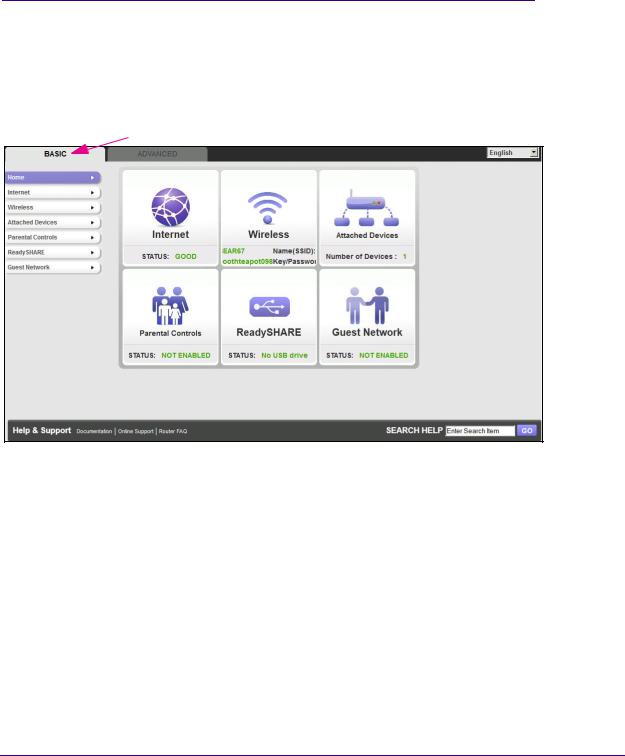
3. NETGEAR genie BASIC Settings |
3 |
Your Internet connection and network |
This chapter explains the features available from the NETGEAR genie BASIC Home screen, shown in the following figure:
This chapter contains the following sections:
•Internet Basic Settings
•Attached Devices
•Parental Controls
•ReadySHARE USB Storage and Printer
•Basic Wireless Settings
•Guest Networks
•NETGEAR genie App
29

D6300 WiFi DSL Modem Router
Internet Basic Settings
The Internet Basic Settings screen is where you view or change ISP information.
1. From the BASIC Home screen, select Internet. The following screen displays:
Scroll to view more settings
The fields that display in the Internet Basic Settings screen depend on whether your Internet connection requires a login.
•Yes. Select the encapsulation method and enter the login name. If you want to change the login time-out, enter a new value in minutes.
•No. Enter the account and domain names, only if needed.
2.Enter the settings for the IP address and DNS server. The default settings usually work fine. If you have problems with your connection, check the ISP settings.
3.Click Apply to save your settings.
4. Click Test to test your Internet connection. If the NETGEAR website does not display within 1 minute, see Chapter 10, Troubleshooting.
Internet Basic Settings Screen Fields
The following descriptions explain all of the possible fields in the Internet Basic Settings screen. Which fields display in this screen depends on whether an ISP login is required.
Does Your ISP Require a Login? Answer either yes or no.
These fields display when no login is required:
•Account Name (If required). Enter the account name provided by your ISP. This name might also be called the host name.
NETGEAR genie BASIC Settings
30
